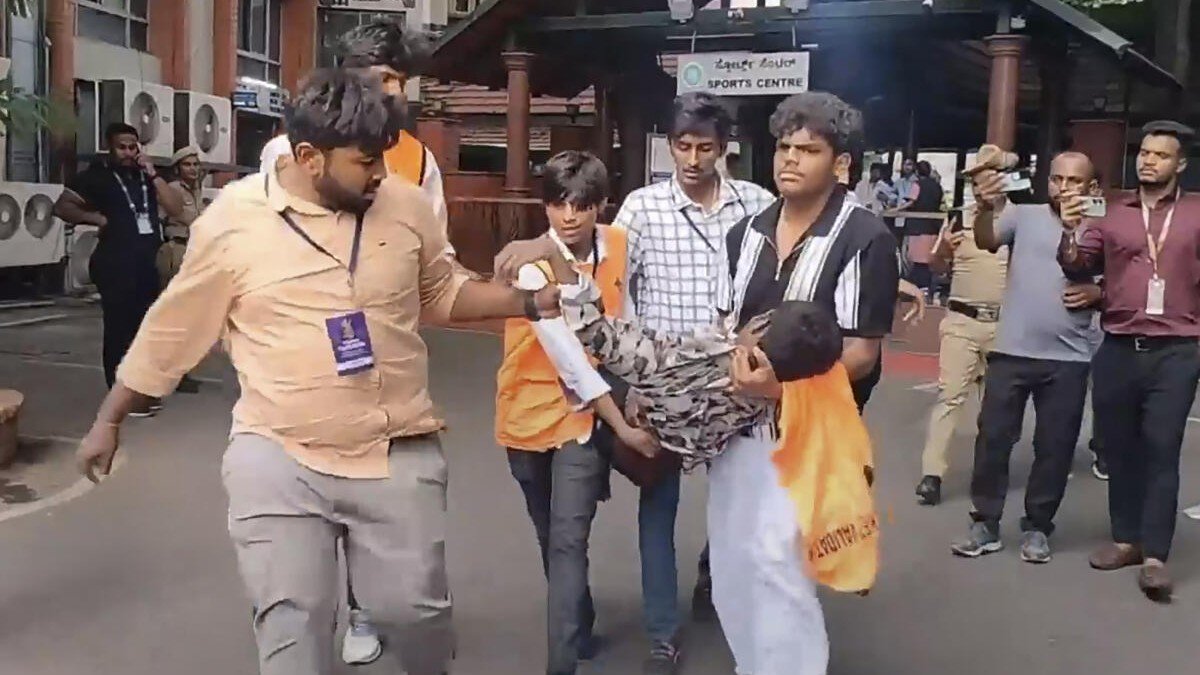India
How Social Media is Fueling Hindu-Muslim Clashes in India.
From viral misinformation to algorithm-driven outrage, digital platforms are accelerating communal tensions across India.

From viral misinformation to algorithm-driven outrage, digital platforms are accelerating communal tensions across the country.

In recent years, India has witnessed a disturbing rise in communal violence, with social media platforms often serving as the catalyst. Incidents like the 2023 Satara riots and the 2020 Bangalore unrest underscore how a single provocative post can ignite widespread conflict. These platforms, designed to connect people, are increasingly being exploited to deepen divisions between Hindu and Muslim communities.
The algorithms that govern content visibility on platforms like Facebook and X (formerly Twitter) are designed to maximize user engagement. Unfortunately, this often means that sensational and polarizing content is prioritized, creating echo chambers that reinforce existing biases. Studies have shown that such environments can accelerate radicalization, as users are continually exposed to one-sided narratives that vilify the ‘other’.
Law enforcement agencies are increasingly recognizing the threat posed by digital misinformation. In Mangaluru, for instance, six individuals were arrested for sharing inflammatory content aimed at disrupting communal harmony. Similarly, the Uttar Pradesh Police have implemented real-time social media monitoring to preempt potential flashpoints during sensitive periods like religious festivals. These measures, while necessary, highlight the reactive nature of current strategies in addressing digital provocations
The psychological impact of online hate speech is profound. Continuous exposure to derogatory content can desensitize individuals, making extremist views seem acceptable. This normalization of hate not only erodes societal cohesion but also emboldens individuals to act on their prejudices, leading to real-world violence. The tragic death of a techie in Pune, following the circulation of morphed images on Facebook, serves as a grim reminder of the tangible consequences of digital hate.
Addressing this multifaceted issue requires a concerted effort from all stakeholders. Social media companies must enhance their content moderation policies, especially in regional languages, to effectively curb the spread of hate speech. Educational initiatives aimed at promoting digital literacy can empower users to critically assess the content they consume and share. Moreover, political leaders and influencers bear the responsibility of fostering narratives that promote unity rather than division.
India
India Unveils the World’s Highest Rail Bridge Built as Part of a $5.5 Billion Mega Project and It’s an Engineering Marvel You Must See
Indian Prime Minister Narendra Modi inaugurates the breathtaking Chenab Bridge and Vande Bharat trains in Jammu and Kashmir, reshaping connectivity and national pride.

In what is being hailed as a monumental moment for Indian infrastructure, the Indian Prime Minister inaugurated the world’s highest railway bridge, the Chenab Bridge, during a landmark visit to Jammu and Kashmir. Standing taller than the Eiffel Tower and part of a massive ₹46,000 crore (approx. $5.5 billion USD) infrastructure push, this achievement isn’t just a symbol of engineering brilliance—it’s a transformative leap in connecting the Kashmir Valley to the rest of India.
The Chenab Bridge, rising 359 meters (1,177 feet) above the riverbed and stretching over 1.3 kilometers, is now officially the tallest railway bridge in the world. Built at a cost of ₹1,486 crore, it took over two decades of precise planning, international collaboration, and sheer grit to complete. Its height exceeds the Eiffel Tower by 35 meters and it’s designed to withstand wind speeds of up to 266 km/h, major earthquakes, and extreme Himalayan weather conditions.
During the inauguration, Indian PM Narendra Modi called the project a dream come true and emphasized its strategic and economic importance: “Now, Kashmir’s apples will reach bigger markets at lower costs and on time.” He also flagged off two Vande Bharat Express trains connecting Katra to Srinagar, reducing travel time significantly and promising smooth connectivity even during the harshest winters.
This project is part of the 272-km-long Udhampur-Srinagar-Baramulla Rail Link (USBRL), a game-changer for the region that includes 36 tunnels, 943 bridges, and India’s first cable-stayed railway bridge at Anji Khad. The rail line now offers all-weather, seamless connectivity through mountainous terrain, allowing not only faster transportation of goods like Pashmina shawls and Kashmiri apples but also boosting tourism and pilgrim travel.
Modi’s visit to the region was his first since Operation Sindoor, a military response to a recent terror attack. It underlined the Indian government’s commitment to long-term peace and development in a historically conflict-prone region. The Prime Minister also took time to meet engineers and workers who had dedicated years of effort to the project’s success, praising their dedication in making what he called “one of India’s greatest civil-engineering achievements.”
Jammu and Kashmir Chief Minister Omar Abdullah also praised the efforts, stating that even the British during colonial rule couldn’t bring rail to Kashmir, but today, thanks to this effort, the region has entered a new era of modern connectivity. “What once felt like a distant dream has now become a living reality,” he said.
The new Vande Bharat Express trains are also packed with state-of-the-art features like silicon heating pads, bio-toilets, anti-spall protection, and an auto-draining mechanism that ensures uninterrupted service even in sub-zero temperatures. With this development, India not only strengthens its transport network but also showcases its growing capability to take on complex infrastructure challenges on a global scale.
World
RCB Victory Turns Into Nightmare as Stampede Outside Stadium Claims 11 Lives
What should have been a historic celebration for Royal Challengers Bengaluru ended in heartbreak as massive crowd mismanagement led to a deadly tragedy

A day meant for celebration turned into a scene of unimaginable sorrow in Bengaluru as at least 11 people lost their lives and over 30 were injured during a stampede outside the M Chinnaswamy Stadium on June 4. Fans had gathered in the lakhs to witness Royal Challengers Bengaluru‘s (RCB) first-ever IPL victory parade—a moment 18 years in the making—but chaos ensued as crowd control failed dramatically.
According to Karnataka Chief Minister Siddaramaiah, more than 2-3 lakh people flooded the streets around the stadium, far exceeding crowd management estimates. The situation spiraled out of control as fans pushed against closed gates and barriers, trying to catch a glimpse of their cricketing heroes. “No one expected this much crowd,” the Chief Minister stated, confirming the tragic toll from the incident.
The stampede occurred near gates 3, 10, and 21 of the stadium, with emergency exits and nearby metro stations, including Cubbon Park and MG Road, being shut down temporarily. The injured were rushed to Bowring Hospital and Vaidehi Hospital, where officials confirmed seven deaths at Bowring and four at Vaidehi.
As news of the tragedy broke, RCB released a heartfelt statement, expressing deep sorrow and offering condolences to the bereaved families. The team cut their celebration short “out of respect” and coordinated closely with local authorities. “RCB mourns the tragic loss of lives,” the statement read.
National leaders and cricketing legends echoed the nation’s grief. Prime Minister Narendra Modi called the tragedy “heartrending” and offered prayers for the injured. President Droupadi Murmu and Vice President Jagdeep Dhankhar also extended their condolences. Former cricket icons like Sachin Tendulkar and Harbhajan Singh expressed heartbreak over the incident, noting how a joyous occasion quickly turned “beyond tragic.”
However, political blame games have intensified. Union Minister H.D. Kumaraswamy accused the Congress-led Karnataka government of ignoring police warnings and failing to anticipate the crowd surge. Union Minister Prahlad Joshi alleged that the police were pressured into approving the felicitation ceremony, calling the tragedy a result of “poor planning.” BJP leaders demanded judicial investigations, while the Congress defended its response, saying it was caught off-guard by the unexpected turnout.
In a gesture of support, the Karnataka government announced ₹10 lakh in compensation for each of the victims’ families. Deputy CM D.K. Shivakumar issued a public apology, admitting the crowd was “uncontrollable” and stated that law enforcement chose not to use force on the “young and vibrant crowd.”
What should have been RCB’s brightest moment now carries a shadow of grief, raising serious questions about event planning, civic preparedness, and crowd safety at public gatherings. As the city mourns, the tragedy serves as a stark reminder of how unchecked excitement can quickly become deadly in the absence of foresight and coordination.
India
Joy Turns Into Tragedy in India as Fans Die in Stampede After RCB’s Historic IPL Win
Celebrations outside Bengaluru’s M. Chinnaswamy Stadium in India take a dark turn as a massive crowd surge leads to multiple fatalities and injuries following Royal Challengers Bengaluru’s first-ever IPL title win.

What began as a jubilant celebration turned into a nightmare on Wednesday outside the iconic M. Chinnaswamy Stadium in Bengaluru, India, where a massive crowd had gathered to honor Royal Challengers Bengaluru’s long-awaited Indian Premier League (IPL) championship victory. As thousands of fans surged forward in the excitement, chaos ensued, resulting in a deadly stampede that left several feared dead and many others critically injured.
According to reports from The Times of India and NDTV, the death toll ranges from seven to as many as eleven, though authorities have yet to release an official count. Heart-wrenching visuals aired on local television showed bodies being rushed into ambulances, while others lay unconscious on the ground, overwhelmed by the sheer crush of bodies. Paramedics and police struggled to bring order to what quickly became a scene of devastation.
Witnesses described a scene of euphoria that spiraled into terror in mere moments. As chants for Virat Kohli and the RCB squad echoed through the air, fans pushed forward toward the stadium gates, many hoping to catch a glimpse of their heroes. The celebration, intended to commemorate RCB’s maiden IPL title win on Tuesday, had drawn an unprecedented crowd — but lacked adequate safety and crowd-control measures.
Karnataka’s Deputy Chief Minister D.K. Shivakumar acknowledged the chaos, admitting to the press that “the crowd was very uncontrollable.” He further added that steps would be taken to ensure such incidents are never repeated at public events of this scale.
The Board of Control for Cricket in India (BCCI), which organizes the IPL, issued a statement mourning the incident. BCCI secretary Devajit Saikia expressed regret, stating, “This is a negative side of popularity. People are crazy for their cricketers. The organizers should have planned it better.” The statement has ignited fresh debates over the responsibilities of event management agencies and government officials during such high-profile gatherings.
Tragically, crowd stampedes are not unfamiliar to India. The country has witnessed similar horrors during large-scale religious events, such as the January tragedy during the Maha Kumbh festival, where at least 30 people died in a similar crush. But this week’s calamity strikes a particularly painful chord — as it overshadowed a moment of national sporting pride and collective joy.
As investigations begin and grief sets in, questions are being raised about the planning, security, and coordination behind the RCB celebration event. While the team and its fans had waited for years to taste IPL glory, the aftermath of this tragic celebration serves as a stark reminder that safety must never be sacrificed in the name of euphoria.
-

 Business & Finance1 week ago
Business & Finance1 week agoElon Musk Breaks Ranks with Trump Over ‘Big, Beautiful’ Tax Bill
-

 Sports1 week ago
Sports1 week agoBlue Jays Humiliated in Tampa as John Schneider’s Comments Raise Eyebrows
-

 Personality5 days ago
Personality5 days agoDonald Trump’s net worth reveals the fortune behind the former US President and business mogul
-

 Entertainment6 days ago
Entertainment6 days agoTop 5 Oscar Moments That Shook Hollywood and the World
-

 Entertainment5 days ago
Entertainment5 days agoJonathan Joss Shot Dead at 59 in Texas Tragedy His Husband Says Was Hate-Fueled Crime
-

 Personality5 days ago
Personality5 days agoLionel Messi’s Net Worth Revealed and How the Football Legend Built His Multi-Million Dollar Fortune
-

 Tech1 week ago
Tech1 week agoTop 7 AI Tools Every Corporate Employee Should Use in 2025.
-

 Films5 days ago
Films5 days agoRobert Pattinson’s Top 5 Films That Showcase His Evolution from Teen Idol to Indie Icon













